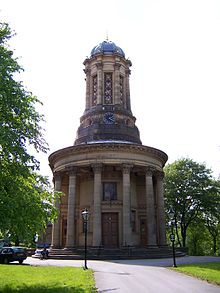Saltaire
Saltaire is a 1851 founded Victorian model village at Bradford in the Metropolitan Borough City of Bradford County West Yorkshire . The settlement got its name after its founder Sir Titus Salt and the river Aire , in whose valley the settlement lies.
In 1851, the cloth manufacturer Titus Salt relocated his company from Bradford to what is now Saltaire, where he had a workers' settlement built around the newly built Salts Mill factory for around 3,000 workers and their relatives according to the most modern social and sanitary principles of the time. In addition to the workers' houses, numerous community facilities were built, including a church, a school, a park, a hospital, wash and bath houses , a poor house , allotments and an educational institute with a library, reading room, concert hall and gymnastics room. A boathouse for the residents and a harbor for the factory were built on the Leeds and Liverpool Canal . On the instructions of Titus Salt, the pub , which is common in English localities, was dispensed with; It is unclear whether this was done for health reasons or whether it was intended to prevent the possible formation of a union in an area that is difficult to control by Salt.
The yellow stone buildings are in the style of the Italian Renaissance . Titus Salt commissioned the most famous architects of the time with the planning and execution, and the Lockwood and Mawson office drew the plans for the overall planning and the residential buildings .
In the former factory buildings are now a wide variety of uses, in addition to an exhibition with works of David Hockney and the Harmonium -Museum Victorian Reed Organ Museum , they also house a shopping center, apartments and manufacturers of consumer electronics .
Today Saltaire is counted among the most important model settlements of the 19th century worldwide. The settlement was added to the UNESCO World Heritage Site in 2001 together with the Derwent Valley and New Lanark industrial landscape and is a so-called anchor point on the European Route of Industrial Culture . The United Reformed Church from 1859 is considered to be one of the most important Victorian church buildings in Great Britain.
Web links
- German abstract
- Presentation of the UNESCO World Heritage Commission with appreciation of the individual buildings (PDF; English / French; 102 kB)
- History of Saltaire (English)
- Saltaire Living History Project (English)
Coordinates: 53 ° 50 ′ N , 1 ° 47 ′ W


